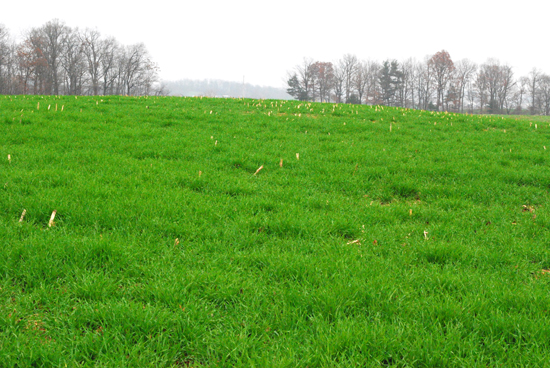Md. farmers plant record acreage of pollution-reducing cover crops
Farmers planted nearly 430,000 acres of cover crops in fall 2011, the largest planting in Md. history.
Maryland farmers planted nearly 430,000 acres of cover crops in fall 2011 through the state’s Cover Crop Program, the largest planting in Maryland history, according to the Maryland Department of Agriculture (MDA). The 2011 figure exceeds Maryland’s 2013 Chesapeake Bay pollution reduction milestone for cover crop plantings by 21 percent.

Cover crops are widely considered one of the most cost-effective and environmentally sustainable ways to control soil erosion and reduce nutrient pollution to the Bay and its rivers in winter. Collectively, the 429,818 acres of cover crops planted in 2011 will prevent an estimated 2.58 million pounds of nitrogen (60 percent of Maryland’s total pollution reduction milestone goal) and 86,000 pounds of phosphorus from entering the state’s waterways.
Farmers plant cover crops such as rye, wheat and barley in the fall after summer crops are harvested. As they grow, cover crops recycle unused plant nutrients remaining in the soil, protect fields against wind and water erosion, and help improve the soil for next year’s crop.
To learn more about Maryland’s cover crop program, visit MDA’s website.

Comments
Cover crops are very efficient in taking up excess nutrients and controlling erosion ONLY if planted early enough to reach of height of 5-6" or more and provide well over 50% ground cover. In order to reach those levels; they need to be planted at least 2 weeks before the 1st killing frost. For mid-Maryland the 1st killing frost is Oct 10th; so the cover crop needs to be planted no later than Sept 26th. The 2nd level would for the cover crop planted by Oct 10th. if planted later than Oct 10th, they provide VERY LITTLE in the way of nutrient removal or erosion control. For the past 2 years, the planting dates have been pushed back to mid-November. Farmers got paid for cover crops that provide no real protection. Cover crops should be part of every farmers conservation plan requirements for being in "baseline compliance". We spent over $21 million for these cover crop; we can't be paying that kind of money year in and year out. That money could be better spent on long-term permanent conservation practices like: stream buffers, runoff from animal concentration areas (barnyards, feedlots). Farmers say they are the 1st environmentalist; they need to plant cover crops because they are good for the environment. Early in the cover crop program a survey showed that 60% of the farmers were going to plant cover crop anyway (even if not paid to do so).
Thank you!
Your comment has been received. Before it can be published, the comment will be reviewed by our team to ensure it adheres with our rules of engagement.
Back to recent stories